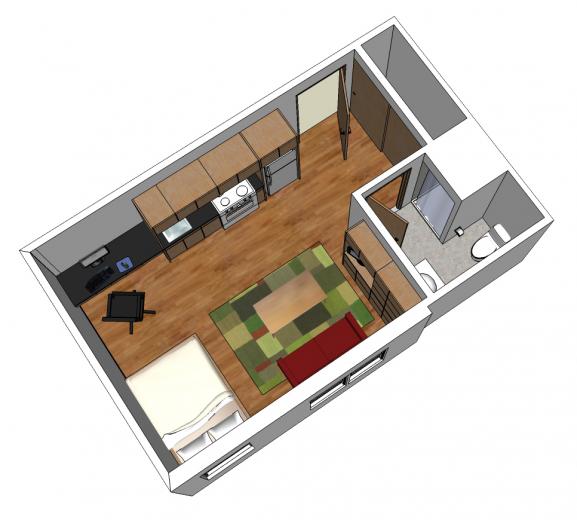1 7
1 7
Although some cities or municipalities may have their own micro-unit definition, there is not yet an industry-wide definition. Studio micro-units typically average 250 sq. ft. to 300 sq. ft. in size. In comparison, traditional studio rentals typically are in the 400-to-600-sq.-ft. range. While greater variation in size is seen among traditional one-bedroom units, standard floor plans average in the mid-700-sq.-ft. range, with more spacious units approaching 1,000 sq. ft. Meanwhile, one-bedroom micro-units top out around 600 sq. ft.
There are three basic groups that appreciate micro-housing: Millennials, seniors and travelers. First-time renters and Millennials who have not yet accumulated space-demanding possessions constitute a significant amount of appeal for these apartments. Oftentimes, this segment is fresh out of the college dorms or their parents’ home, so they are looking for a foot in the door to their independence and adulthood. To Millennials, flexibility, mobility and good locations within metro areas’ urban cores are of the utmost importance, and micro-units are able to provide all those features and at a relatively lower cost than traditional units. But seniors make up a portion of interested renters. In addition to sharing similar motivations as millennial tenants, older renters may also be driven by a desire to be free of mortgages, maintenance and property taxes while enjoying their retirement. And the micro-unit is being utilized as a pied-a-terre for seasonal occupancy by out-of-state or foreign visitors or habitual travelers.
Overall, micro-unit apartments are stable investment strategies due to forecasted persistent demand for quality multifamily housing in urban environments. For many renters, micro-units are their first foray into class-A multifamily housing. As their incomes increase, they’ll eventually take on larger units. On a market-to-market basis, micro-unit investment demand persists, but the differing economies and supply constraints alter the metrics of deals. In coastal markets, near tech hubs and areas with mass-transit-dependent populations, renters will pay a premium for these units. Investors, in turn, will be more willing to accept higher per-sq.-ft. prices and greater levels of competing supply, because more renters utilize micro-units out of necessity.
There is pricing synergy: the more a consumer buys, the lower the cost to add additional units. In regard to both developing and leasing micro-units, the additional units are square footage. Greater per-unit costs are incurred at the lower end of the scale, but costs are increasingly diffused as square footage is added. For this reason, an apartment operator can offer a 500-sq.-ft., one-bedroom micro-unit for $3,000 per month in Santa Monica, compared to $3,600 per month for a 750-sq.-ft. traditional unit. The traditional unit rents at $4.80 per sq. ft. compared to $6 per sq. ft. for the micro-unit, as the renter of the traditional unit is accepting a 20 percent increase in rent for a 50 percent increase in square footage.
Quick lease-up and waiting lists at well-located apartment communities are evidence of deep, pent-up demand for micro-units. Despite renters’ preference for this type of multifamily product, investment and development has only recently rebounded. Lenders typically like to rely on a multitude of similar sales comps when underwriting debt. Given the recent and compelling emergence of this multifamily type, the small proportion of these sales can make the underwriting process slightly more complicated.
In the current marketplace, demand is strong, with renters opting to join waiting lists for micro-units in good locations and with a high level of amenities. Micro-units have been around for decades, and were previously known as SRO, or single-room occupancy, housing. SRO housing particularly flourished in the 1980s; however, the emergence of Millennials and their distinct consumer and demographic preferences have supported both a rebound in construction in this segment and an evolution in how these micro-units are developed and marketed to renters.
Micro-unit occupancy will remain elevated in barrier-to-entry markets, where employment-generated demand will fuel housing needs, but high land and development costs will keep costs high for both renters and homeowners. Primary metros like Los Angeles, New York City, San Francisco, Seattle, San Jose and Washington, D.C., will perpetually maintain a high cost of living and will be most conducive to micro-units. Demand will also be prevalent in urban cores of secondary markets, where young professionals’ preference for centrally located housing will bolster demand for micro-units.

